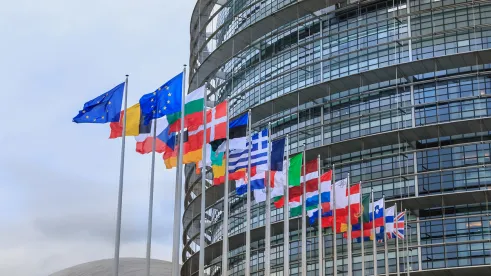This week sees the introduction of significant changes to the rules and regulations governing the marketing of alternative investment funds (“AIFs”) to investors in the Member States of the European Economic Area (the “EEA”) with both the deadline for implementation of the Cross Border Marketing Directive[1] (the “Directive”) and the Cross Border Marketing Regulation[2] (the “Regulation”) coming into force. For the avoidance of doubt, the EEA no longer includes the United Kingdom.
The New, Unified Pre-Marketing Regime
Since the introduction of the EU Alternative Investment Fund Managers Directive[3] (the “AIFMD”), one of the fundamental issues for managers has been the inconsistent application of marketing rules in individual member states around the ability of managers to approach potential professional investors and to sound out their potential interest in an AIF before having to make a formal registration under the relevant national private placement regime (“NPPR”) for a non-EEA AIF or file for a passport for an EEA AIF. A key component of the new Directive is an attempt to bring in a harmonised regime of definitions and procedures around “pre-marketing” of AIFs in the EEA for this purpose.
For the purposes of the AIFMD, “marketing” means a direct or indirect offering or placement at the initiative of the alternative investment fund manager (“AIFM”) or on behalf of the AIFM of units or shares of an alternative investment fund it manages to or with investors domiciled or with a registered office in the EEA. An EEA-AIFM needs to ensure a “passport” for the purposes of AIFMD is in place and a non-EEA AIFM needs to conduct such marketing following registration or approval under the relevant Member State’s NPPR. Both routes involve the AIFM incurring compliance and reporting obligations in relation to the local regulator and investors. An AIFM that fails to do so risks incurring fines and public censure and any subscriptions entered into as a result of unauthorised marketing may be unenforceable.
On the other hand, a new definition of “pre-marketing” is now inserted in AIFMD, which means the provision of information or communication, direct or indirect, on investment strategies or investment ideas by an EEA AIFM or on its behalf, to potential professional investors domiciled or with a registered office in the EEA in order to test their interest in an AIF or a compartment which is not yet established, or which is established, but not yet notified for marketing in accordance with Article 31 or 32, in that Member State where the potential investors are domiciled or have their registered office, and which in each case does not amount to an offer or placement to the potential investor to invest in the units or shares of that AIF or sub-AIF.
The information presented to potential professional investors must not:
-
be sufficient to allow investors to commit to acquiring units or shares of a particular AIF;
-
amount to subscription forms or similar documents whether in a draft or a final form;
-
amount to constitutional documents, a prospectus or offering documents of a not-yet-established AIF in a final form; or
-
contain information sufficient to allow investors to make investment decisions.
Practically, this means that a manager should not send out subscription agreements (even in draft form) prior to any registration for marketing being in place and all AIF documents should be sent out clearly in draft form and with additional disclaimers included for the purpose.
Under the Directive, an EEA AIFM must send a notification to its own regulator specifying in which Member States it has been conducting pre-marketing, within two weeks of having begun pre-marketing, listing the AIFs or sub-AIFs which it has been testing appetite for.
Application of the New Rules to NPPR
The pre-marketing rules in the Directive technically only apply to EEA AIFMs managing EEA AIFs. This is because the passported marketing regime between Member States is intended to be “maximum harmonisation”, whilst NPPR is “minimum harmonisation”, which means that each Member State may decide whether to adopt NPPR at all and, where so, how much to “gold plate” the rules. Consistent with this approach, the Directive makes it clear in the recitals that Member States should ensure that their implementation of the Directive, and in particular the pre-marketing regime, should not in any way disadvantage EEA AIFMs vis-à-vis non-EEA AIFMs, so the same approach to pre-marketing and marketing documentation should be assumed to be a baseline for approaching EEA investors. As yet, it is only starting to become apparent to what extent Member States will adopt the same rules in respect of third-country AIFMs going through the various NPPRs, including the need to notify regulators of pre-marketing activities. However, at this early stage it appears that the most NPPR friendly jurisdictions are adopting a level playing field approach to the rules.
Where Does This Leave “Reverse Solicitation”?
Reverse solicitation covers a situation whereby a professional investor located in the EEA may invest in AIFs on its own initiative. The Directive now makes it clear that there can be no reverse solicitation of an investor who is the recipient of any “pre-marketing”. In addition, the Directive clarifies that any subscription by professional investors within 18 months of the AIFM having begun pre-marketing shall be considered to be the result of marketing. What remains unclear is the extent to which this 18-month moratorium applies to each investor, to each country or indeed across the whole EEA. In the absence of taking specific advice on the interpretation in a particular jurisdiction, it would be sensible to assume that this applies on a member state basis and that, once any pre-marketing has been conducted in that member state, registration will be necessary to close in any investors from that jurisdiction for the following 18 month period (be aware that it is still possible certain Member States will take an even more restrictive interpretation and assume the 18 month period applies across the EEA).
When Exactly is the Directive in Force?
Whilst many key Member States have already met the 2 August 2021 deadline, there are some Member States who have not yet adopted local legislation implementing the Directive. Since there will be potential differences in transposition and implementation of the Directive’s requirements, particularly for non-EEA AIFMs, outcomes may be different in the Member States and local advice should be taken before proceeding.
Marketing Documentation
In addition to the Directive, the Regulation now brings in a harmonised regime for EEA AIFMs to consider in terms of the preparation and contents of marketing communications, including a framework against which national regulators can ensure that marketing communications comply. In particular, the Regulation requires that such communications fair, clear and not misleading and adequately describes the risks and rewards of investing in the AIF.
Under the Regulations, ESMA is empowered to issue Guidelines with more detail on how to comply with those requirements, which were issued in March 2021[4] and will come into force this autumn. As with the pre-marketing rules, the requirements of the Directive and the ESMA Guidelines strictly only apply to EEA AIFMs but again it would be sensible to assume national implementation will ensure at least a level playing field with non-EEA AIFMs marketing to potential EEA investors.
The ESMA Guidelines make it clear that any general publication of references to an AIF can only be made once the relevant marketing approvals are in place (as opposed to the limited and direct nature of pre-marketing). The Guidelines cover all promotional documents which make reference to specific AIFs (or which are implicitly identified), regardless of format or medium, including social media. However, this does not cover the legal and regulatory documentation for the AIF itself including financial reports and meeting notices. Marketing communications must clearly be identified as such (even to the extent of including an appropriate hashtag) and shorter communications must always contain a disclaimer referring potential investors to the main offering document and ensuring that any information is always presented in a manner consistent with the full documentation suite.
The Guidelines then go into more detail on ensuring the fair presentation of risks and rewards and that communications are fair, clear and not misleading, not least in relation to information on costs, past and future performance and sustainability-related aspects, which must tie in appropriately with the EU Sustainable Finance Disclosure Regulation (the “SFDR”)[5].
FOOTNOTES
1 Directive (EU) 2019/1160 with regard to cross-border distribution of collective investment undertakings
2 Regulation (EU) 2019/1156 on facilitating cross-border distribution of collective investment undertakings
3 Directive (EU) 2011/61 on Alternative Investment Fund Managers and amending Directives 2003/41/EC and 2009/65/EC and Regulations (EC) No 1060/2009 and (EU) No 1095/2010
4 See the Guidelines here
5 Directive (EU) 2019/2088 on sustainability‐related disclosures in the financial services sector








 />i
/>i
